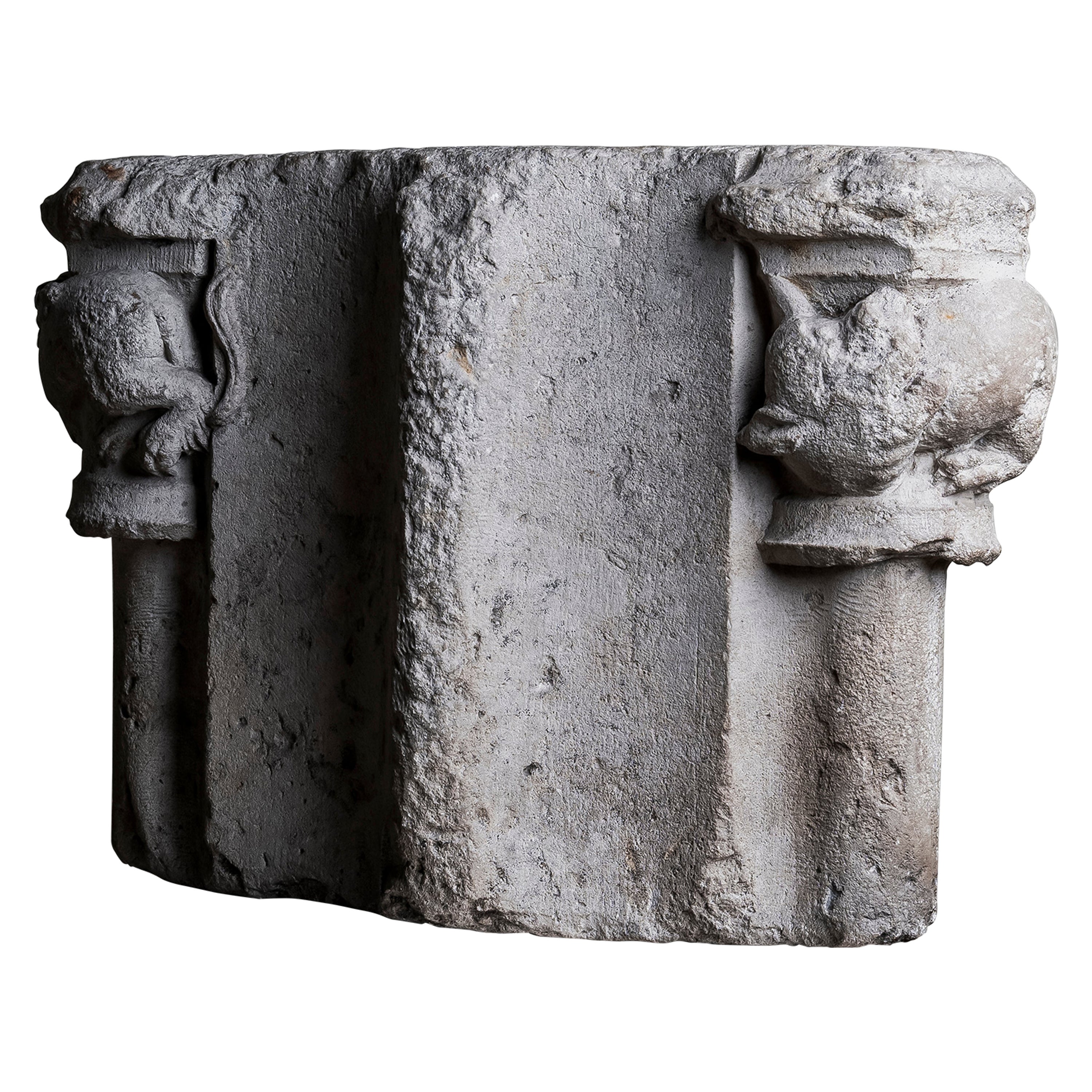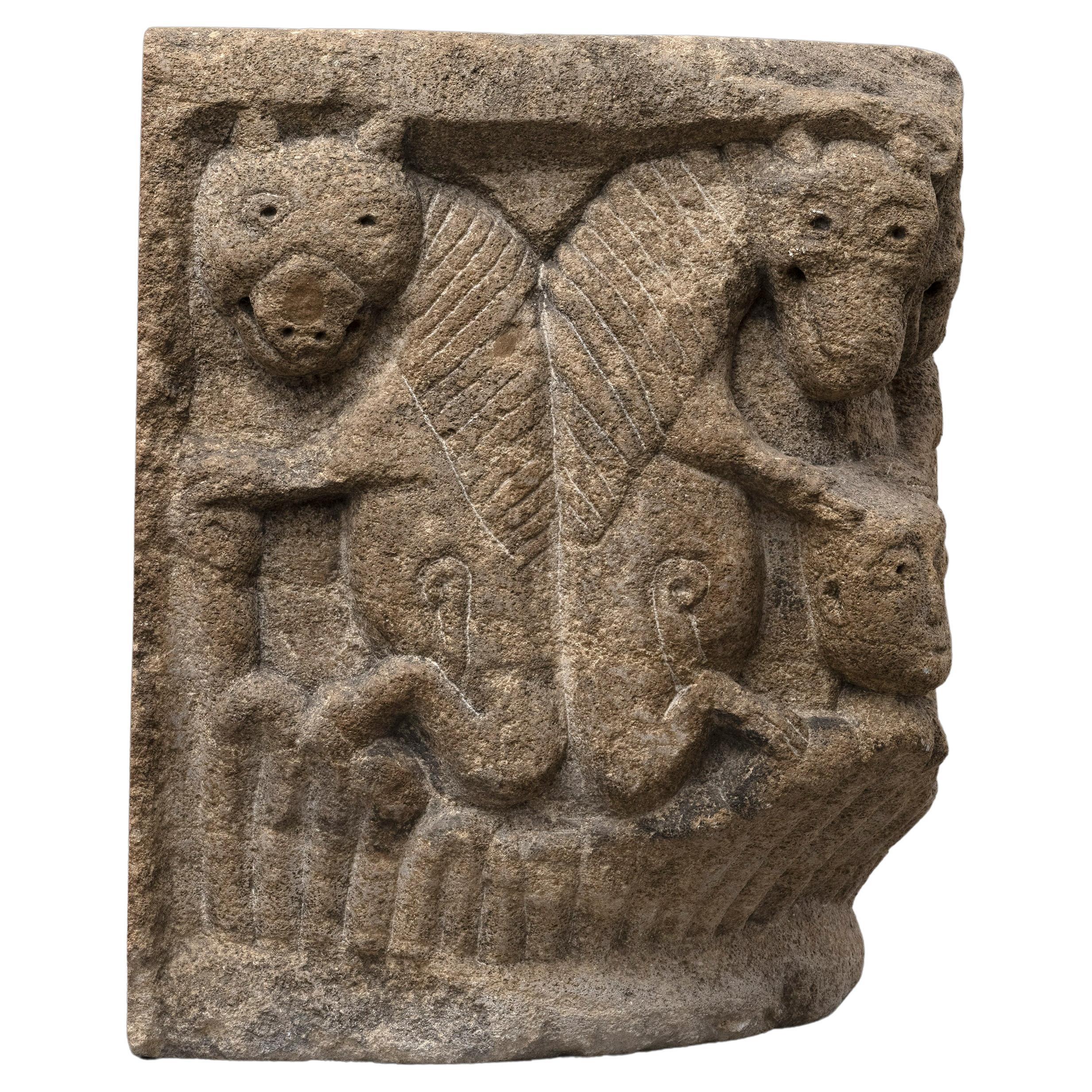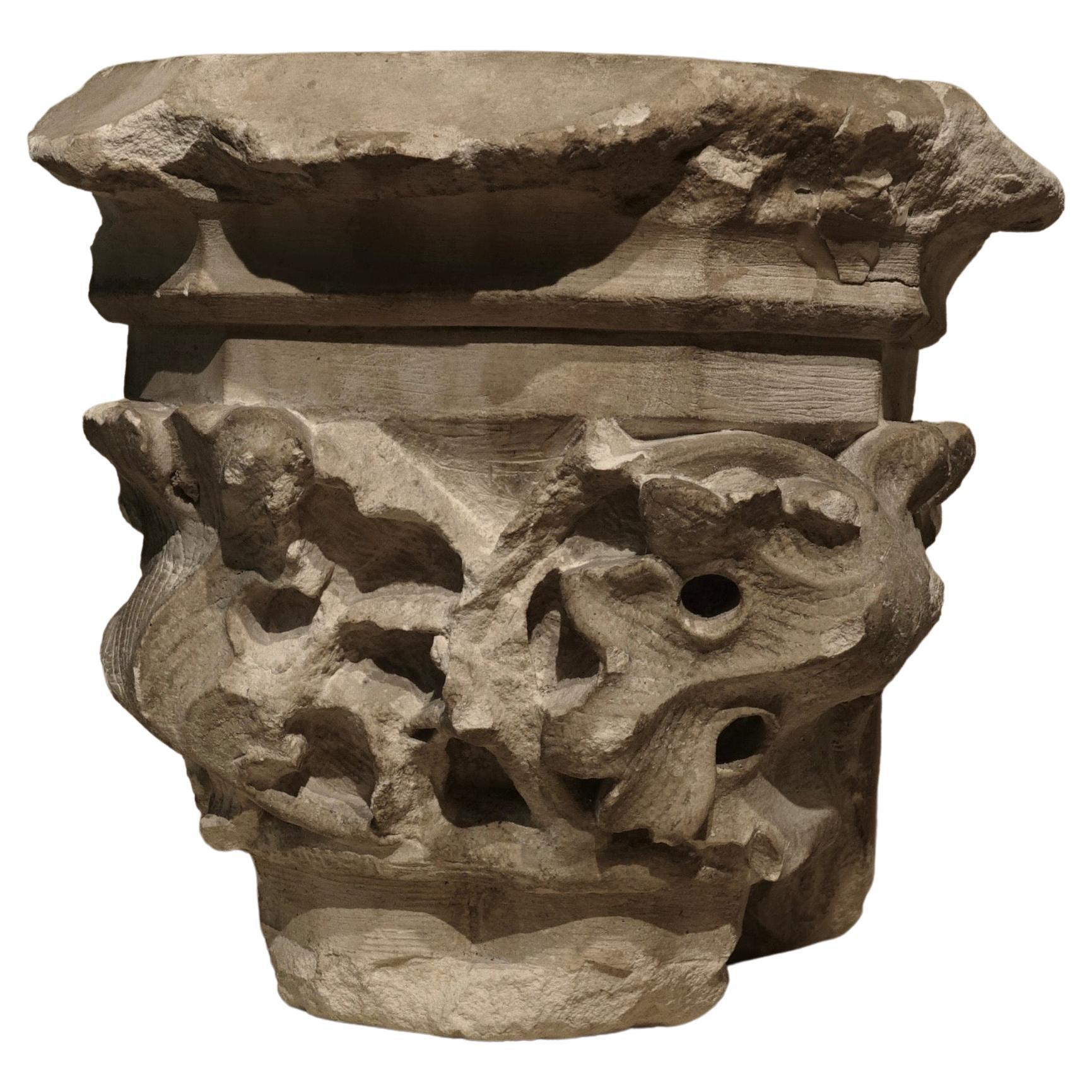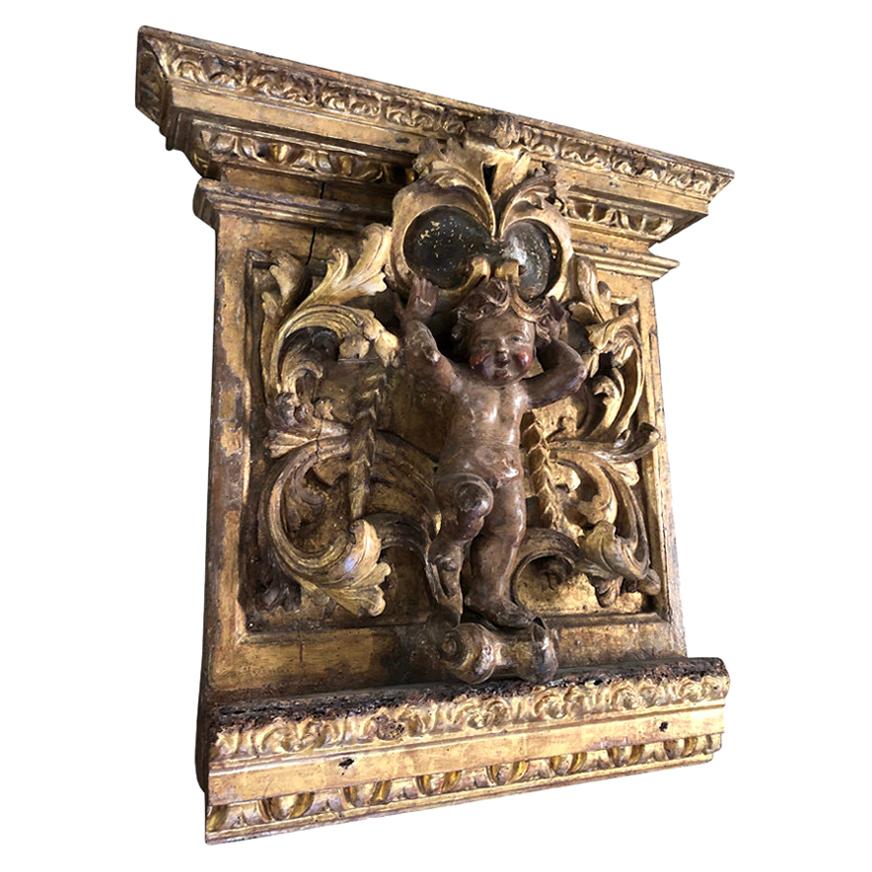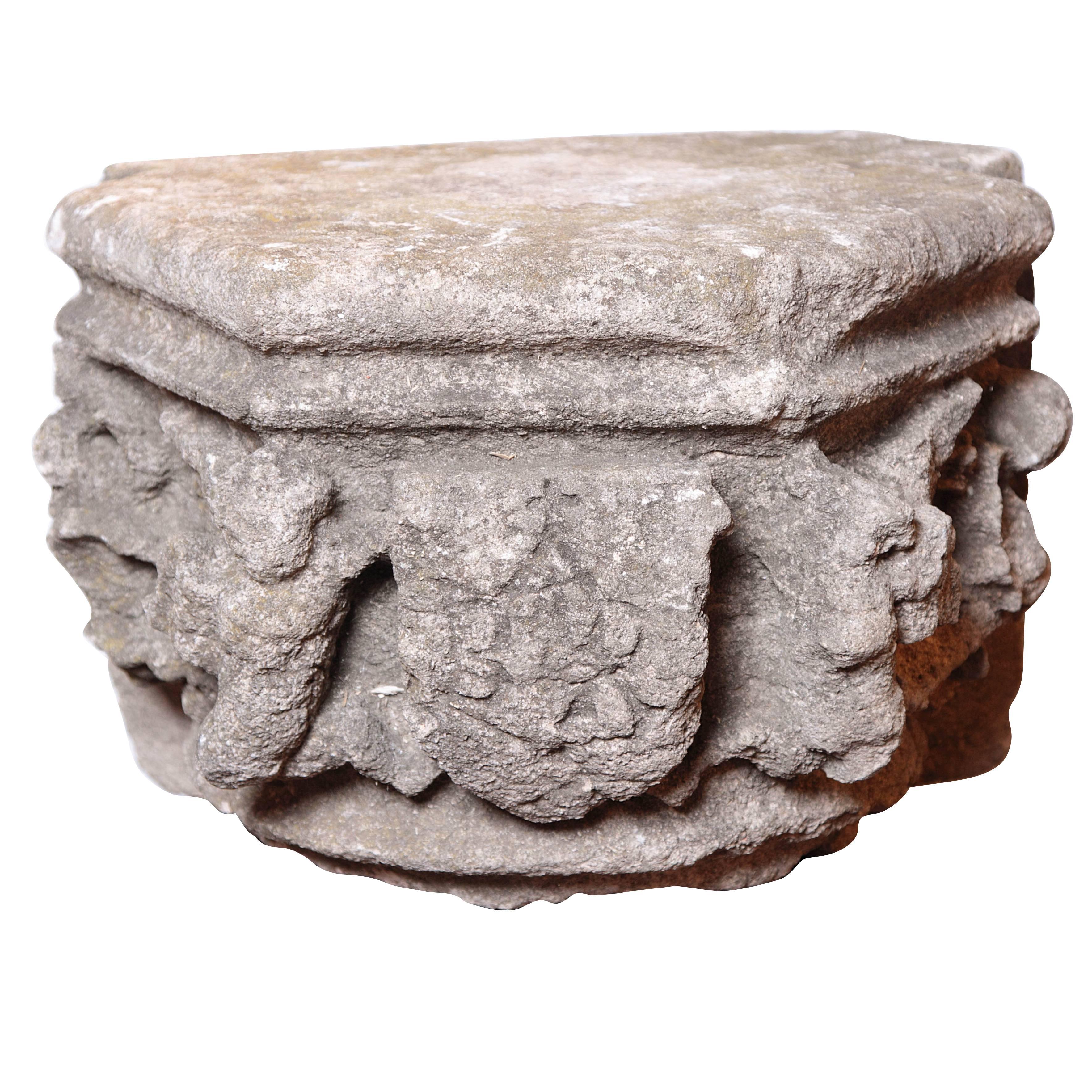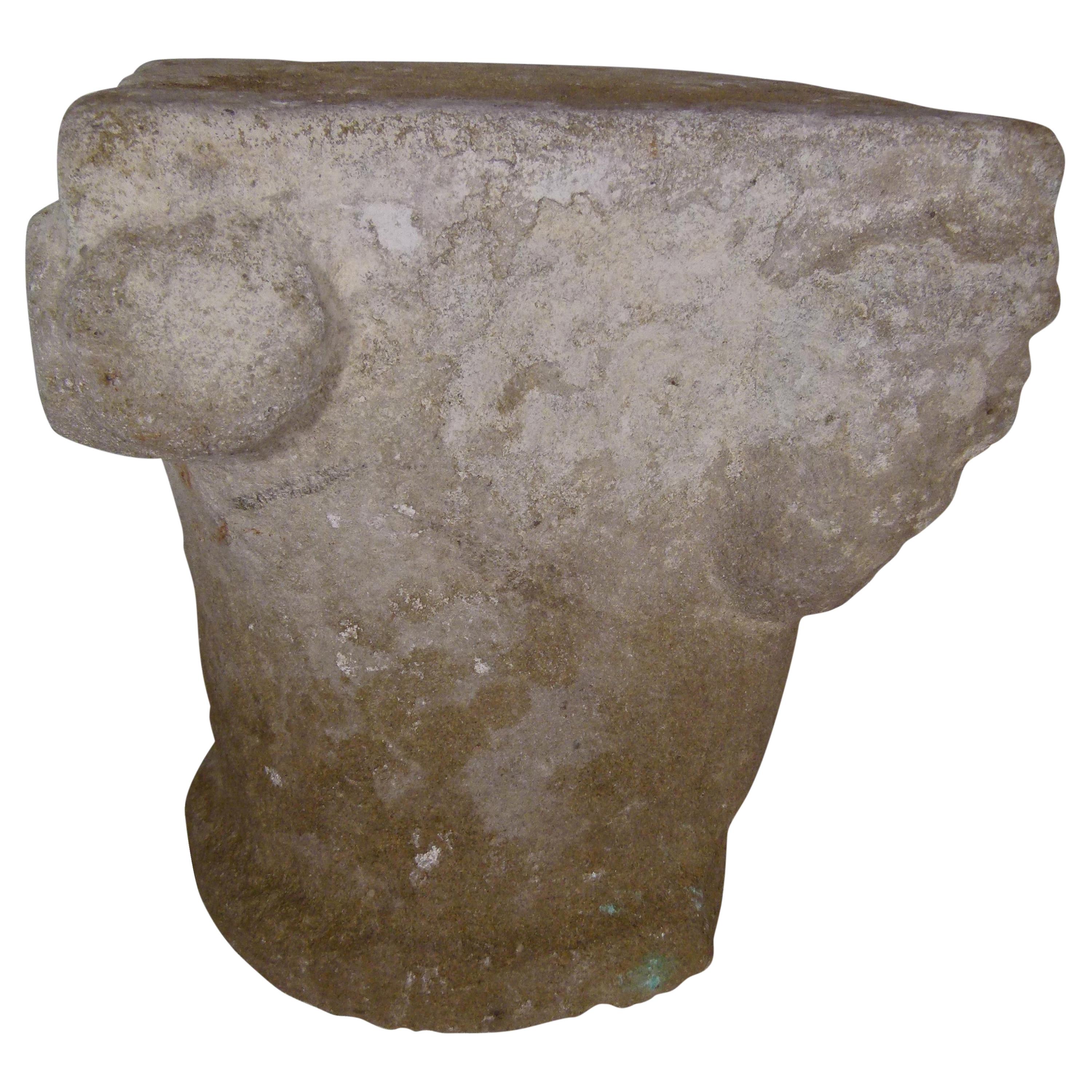Items Similar to Rare Romanesque Capital Depicting Four Africans, Apulia, 13th Century
Want more images or videos?
Request additional images or videos from the seller
1 of 6
Rare Romanesque Capital Depicting Four Africans, Apulia, 13th Century
About the Item
Large stone capital carved on each side in strong relief. The basket is covered with two crowns of vertical acanthus leaves which sprout from the astragal and fill the space between the human heads which decorates each side; each angle is underlined by a volute which accentuates the square format. The motif of heads emerging from foliage follows a well-established late Roman tradition, of which examples are still found in Apulia.
The four heads, carved in high relief, have facial features that identify them as black Africans : they have full lips, wide noses and the tightly curled hair covers only the upper part of their ears; they have closely set eyes, with convex eyeballs.
The creator of the capital actually knew black people: the difference in hairstyle, one with braided hair, the other with hair in small curls is a particularly naturalistic touch which falls outside the limits of the accepted medieval stereotype of black Africans.
One of the important achievement of visual art in the west during medieval period was the rediscovery of an effective means of depicting human racial variation.
There was in Apulia ample opportunity for the study of the appearance of African Saracens and in the late 12th century positive images of black Africans began to increase. This phenomenon was encouraged by a developing interest in blacks on the part of the Hohenstaufen emperors Henry VI and Frederick II. Henry's conquest of Sicily in the 1190s brought a number of black Moslems under his rule, and miniatures from the period record this fact. Also, the court of Frederick II of Hohenstaufen (1194–1250), a center of intellectual exchange in his time, shows black Africans in an array of positions that would later recur in Renaissance and Baroque court culture. In the 1220s Frederick, the German king, Roman emperor (from 1220), and successor of the Norman kings in Sicily, established an Islamic colony which included a number of blacks at Lucera in Apulia, and at least three sculptures can be associated with these Africans. One is a capital from Troia depicting a remarkably naturalistic black as well as other varied ethnic types. The second is the four-headed capital at the Metropolitan Museum of Art. The third work is a portrait of Johannes Maurus, a black who was Frederick's chamberlain.
Those sculptures signify more than a record of the Black presence in southern Italy at this time. The representation of Africans was new to the art of Apulia and even after the fall of the Hohenstaufen, artists made repeated references to the family's fondness for black people in art and in life. The two blacks who appear in the Adoration of the Magi on Nicola Pisano's Siena pulpit are undoubtedly based on African retainers at the Hohenstaufen court.
Clearly our capital and the one at the Metropolitan Museum of Art as well as the capital from Troia are associated by subject matter and, to a degree, by style. The unusual iconography suggest that our capital is the product of a very peculiar cultural back ground which can be found in the cosmopolitan atmosphere of 13th century South of Italy.
Bibliography:
David Abulafia, Frederick II: A Medieval Emperor,Oxford University Press, 1988
Henri Bresc, « Frédéric II et l’Islam », dans Anne-Marie Flambard Héricher (dir.), Frédéric II (1194-1250) et l’héritage normand de Sicile, Caen : Presses universitaires de Caen, 2001
Sam Fogg, architecture & ornament, 22 October - 19 November 2020, London
Sylvain Gouguenheim, Frédéric II, un empereur de légende, Paris, Perrin, 2015
Paul H. D. Kaplan. “Black Africans in Hohenstaufen Iconography.” Gesta, vol. 26, no. 1, [University of Chicago Press, International Center of Medieval Art], 1987, pp. 29–36
Ostoia Vera K. ‘To Represent What Is as It Is.’” The Metropolitan Museum of Art Bulletin, vol. 23, no. 10, The Metropolitan Museum of Art, 1965, pp. 367–72
Dorothea Weltecke, « Emperor Frederick II, « Sultan of Lucera », « Friend of the Muslims », promoter of cultural transfer : controversies and suggestions », dans Jorg Feuchter (dir.), Cultural Transfers in Dispute: Representations in Asia, Europe and the Arab World since the Middle Ages, Chicago, University of Chicago Press, 2011.
- Dimensions:Height: 13.78 in (35 cm)Width: 16.15 in (41 cm)Depth: 16.15 in (41 cm)
- Style:Medieval (Of the Period)
- Materials and Techniques:
- Place of Origin:
- Period:
- Date of Manufacture:13th Century
- Condition:Minor losses.
- Seller Location:Bruxelles, BE
- Reference Number:1stDibs: LU6666231859242
About the Seller
5.0
Vetted Seller
These experienced sellers undergo a comprehensive evaluation by our team of in-house experts.
1stDibs seller since 2022
6 sales on 1stDibs
Typical response time: 7 hours
- ShippingRetrieving quote...Ships From: Bruxelles, Belgium
- Return PolicyA return for this item may be initiated within 3 days of delivery.
More From This SellerView All
- Double Romanesque Capital, France, 13th CenturyLocated in Bruxelles, BEDouble romanesque capital decorated with two fantastic animals France, 13th century Measures: 26,5 x 38,5 x 14,5 cm. This rare double cap...Category
Antique 15th Century and Earlier French Medieval Architectural Elements
MaterialsStone
- Romanesque capital with sirens - France 13th centuryLocated in Bruxelles, BERare romanesque capital with sirens France, XIII century Limestone 25 x 28 x 22 cm This finely carved Romanesque capital, executed in high relief from limestone, features four hyb...Category
Antique 15th Century and Earlier French Medieval Figurative Sculptures
MaterialsStone
- Rare Romanesque Capital Representing Daniel in the Lion’s Den, 12th CenturyLocated in Bruxelles, BEEngaged Romanesque capital representing Daniel in the Lion’s den France, 12th century Limestone 38 x 29 x 18 cm Provenance : Private coll...Category
Antique 15th Century and Earlier French Medieval Architectural Elements
MaterialsLimestone
- Gothic Capital with Foliate Decoration, 13th CenturyLocated in Bruxelles, BEGothic capital with foliate decoration France, limestone 13th century 16.5 x 17 x 12.5 cm The leaves are organically arranged around the core of...Category
Antique 15th Century and Earlier French Medieval Architectural Elements
MaterialsLimestone
- Gothic Stone Fragment Representing Vine Leaves, France, 15th CenturyLocated in Bruxelles, BEGothic architectural fragment representing vine leaves France, 15th century Sandstone H 21 x 21 x 17 cm mounted on a modern metal pe...Category
Antique 15th Century and Earlier French Gothic Architectural Elements
MaterialsLimestone
- Virgin and the Child, Mosan Region, Second Half of 13th CenturyLocated in Bruxelles, BEA polychrome sculpture depicting the Virgin and the Child Mosan region, second half of 13th century Polychrome wood 73 x 29 X 12 cm Provenance : Former Belgian private collection from the beginning of the 20th century This remarkable early artwork portrays the Enthroned Virgin and Child, also known as Sedes Sapientiae, which translates to the 'Seat of Wisdom...Category
Antique 15th Century and Earlier Belgian Medieval Figurative Sculptures
MaterialsWood
You May Also Like
- 17th Century French Capital FragmentLocated in Atlanta, GAAn outstanding and exquisite 17th century French capital to a pilaster. Expertly carved from wood with a wonderful cherub stunningly finished in water gilding and polychrome. A excep...Category
Antique 17th Century French Architectural Elements
MaterialsWood
- Rare 16th Century Architectural Stone Capital from FranceLocated in Dallas, TXThis rare fragment was salvaged from an entryway on a building in Fontvieille, near the city ancient Arles, France. There is a worn and carved center cartouche depicting a very small...Category
Antique 16th Century French Gothic Architectural Elements
MaterialsStone
- Romanesque Hand Carved Limestone Capital from SpainLocated in Vulpellac, GironaBeautiful Romanesque hand carved Capital with two faces figures - one is missing - and two round spheres. A unique piece for your collection. Beautiful Spanish Romanesque hand ca...Category
Antique 15th Century and Earlier Spanish Other Architectural Elements
MaterialsLimestone
- 17th Century Stone CapitalLocated in Vosselaar, BEA large 17th century French capital on a associated base. Sculpted front and sides, flat backside. Great to decorate a garden or display indoors.Category
Antique Late 17th Century French Baroque Architectural Elements
MaterialsSandstone
- Antique Salvaged Hand Carved Carrera Marble Fragment Depicting Joan of ArcLocated in Hamilton, OntarioThis salvaged carved architectural element is unsigned, but presumed to have originated from France and date to approximately 1835 and done in a Neoclassical style. This antique frag...Category
Antique Early 19th Century French Neoclassical Architectural Elements
MaterialsCarrara Marble
- Rare 13th Century Medieval English Oak DoorLocated in Wormelow, HerefordshireA substantially constructed, heavy medieval era English oak door possibly dating from as early as the 13th century. This 800-year-old door is a rare find and originates from Leominst...Category
Antique 15th Century and Earlier Medieval Doors and Gates
MaterialsMetal, Iron
Recently Viewed
View AllMore Ways To Browse
Four Centuries
Architectural Study
Architectural Studies
Four Elements
Rare Elements
Set Of Architectural Studies
Space Age Architecture
Roman Architecture
Large And Rare Stone
13th Century
Capital Base
Medieval Italian
Italian Medieval
Italy Medieval
15th Century Italian
15th Century Italy
The Crown Building
13th Century Furniture
